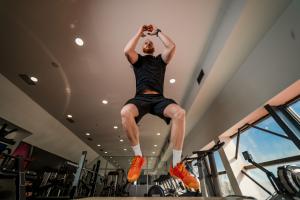
The Brookbush Institute Publishes NEW Glossary Updates: 'Counter-movement Jump' and 'Power'
The Brookbush Institute continues to enhance education with new courses, a modern glossary, an AI Tutor, and a client program generator.
- Additional Glossary Term: Power
- Prepare for the Brookbush Institute: Certified Personal Trainer (CPT) Certificate
DEFINITION
The Counter-movement Jump (CMJ) is a vertical jump performed with a preparatory downward movement prior to take-off (the "counter-movement"). It begins with a quick eccentric/pre-stretch phase (rapid squat-like descent and arm backswing), followed by a brief amortization phase (transition), and ends with a forceful concentric phase (upward jump). This jump pattern utilizes the stretch-shortening cycle (SSC) to enhance power output by optimizing elastic energy storage, stretch reflex activation, and neuromuscular coordination.
The CMJ is widely used in sports performance testing to assess lower-body power and rate of force development (RFD) . It is often contrasted with the squat jump (which begins from a static position) to evaluate an athlete’s ability to use the SSC effectively.
FREQUENTLY ASKED QUESTIONS
What is the purpose of the counter-movement in a CMJ?
- The counter-movement enhances jump height by using the stretch-shortening cycle. The pre-stretch results in stored elastic energy in tendons and muscles, and activates the stretch reflex, both of which contribute to a more powerful concentric contraction.
How is the CMJ different from a squat jump?
- A squat jump begins from a static position without a prior descent, eliminating the stretch-shortening cycle. The CMJ includes a dynamic pre-load (eccentric phase), which typically results in higher jump heights and greater peak power output.
What does the CMJ test measure?
- The CMJ is primarily used to assess explosive lower-body power and, indirectly, neuromuscular readiness, fatigue, or asymmetries. It is a common performance metric in strength and conditioning, rehabilitation, and sports science.
What are the phases of the counter-movement jump?
- Eccentric Phase: Rapid descent and arm backswing
- Amortization Phase: Shortest possible pause at the bottom
- Concentric Phase: Explosive upward jump
Can CMJ performance be improved with training...
FOR THE FULL TEXT AND SO MUCH MORE, CLICK ON THE LINK
Brent D Brookbush
Brookbush Institute
Brent@BrookbushInstitute.com
Visit us on social media:
Facebook
X
LinkedIn
Instagram
YouTube
TikTok
Other
Distribution channels: Education, Healthcare & Pharmaceuticals Industry, Science, Social Media, Sports, Fitness & Recreation
Legal Disclaimer:
EIN Presswire provides this news content "as is" without warranty of any kind. We do not accept any responsibility or liability for the accuracy, content, images, videos, licenses, completeness, legality, or reliability of the information contained in this article. If you have any complaints or copyright issues related to this article, kindly contact the author above.
Submit your press release
